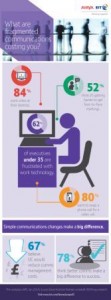
British people are fundamentally changing the way they deal with their banks, building societies and insurers, according to a new study by BT and Avaya.
In the two years since the companies last conducted a similar study*, the number of different ways (or channels) that people use to contact their financial services providers has grown by forty-four per cent. In 2012, people contacted their banks, building societies and insurers using an average of 4.3 different channels, such as face-to-face at the branch, telephone, mobile app, website, ATM machine, social media and by post. The new study finds that in 2014, people use an average of 6.2 channels.
Much of this growth is the result of a surge in the number of people using digital channels such as mobile apps, web chat and video calls to interact with their financial services provider. The number of people using mobile apps has leapt from seven per cent in 2012, to 23 per cent in 2014. Webchat has grown from one per cent to 11 per cent in the same period. And video is beginning to be used for the first time, with three per cent of people having tried it to contact their financial services companies in 2014 (versus zero per cent in 2012).
Social media is also growing in popularity as a contact channel, with the study showing that the number of people using Facebook to interact with their financial services providers has grown from three per cent in 2012 to eight per cent in 2014. Twenty-five per cent of people say that they would like to engage with their banks, building societies and insurers via social media, with 24 per cent happy to engage via Twitter.
But despite the growing use of these digital channels, it appears that people still want the human touch traditionally delivered by their bank or building society branch. The study found that four out of five people visited a branch in the year prior to being surveyed. And almost half (48 per cent) say that having a named individual to email or phone would help them warm to their financial services providers.
The emergence of video as a new contact channel could help financial services companies provide a human touch in the new digital age. One half of people say that video would help build trust and a similar number say it could contribute to a better relationship with their financial services provider.
The study finds that 52 per cent of people buy more from finance companies that are easy to do business with. Yet some people say they are frustrated by inconsistencies across banks’, building societies’ and insurers’ different channels. For example, 26 per cent of people phoning a contact centre worry that the service they want won’t be available versus only 17 per cent visiting a branch.
Sixty-eight per cent of people say that they use self-service for simple transactions – up eight percentage points in two years. The cost to a company of handling a self-service interaction can be as little as one tenth of that of a regular telephone enquiry, freeing up companies’ budgets to invest in improving overall customer experience. But the survey also suggests that a balance needs to be struck by finance companies in how they use this technology. Fifty-five per cent of people think that banks, building societies and insurers have focused too much on automating services and 57 per cent say that they are too faceless.
Tom Regent, president, global banking and financial markets, BT Global Services, said: “Banks, building societies and insurers looking to build loyalty and win new business will find this research very useful indeed. It captures a step-change in how people interact with their financial services providers.
“The research shows that people have a huge appetite for new technologies that make companies easy to do business with but still want the human touch of traditional service. Successful financial services companies will be those that strike the right balance between automation and human interaction — whether that interaction takes place face-to-face or is delivered over the phone, video or web-chat. Through our portfolio of branch and contact centre technology and services, BT and Avaya can help banks, building societies and insurers offer all the communication channels people expect in the most integrated and cost-effective way, helping them grow customer loyalty and win new business.”
Simon Culmer, managing director of Avaya in the UK and Ireland, said: “With over four out of five people having visited their branch in the year prior to the survey, this research tells us that customers aren’t substituting one channel for another. Instead, customers are happy to combine traditional channels with digital ones to achieve the best result.
“This increasing customer dexterity poses a real opportunity for savvy companies to differentiate themselves. By delivering an omnichannel customer service experience which is consistent yet tailored to individual preferences and habits, financial services companies can finally start to deliver an in branch-quality experience across any channel or device.”
BT has been working with financial services companies for over 30 years, from international trading floors to retail bank branches, insurance companies’ contact centres to major corporate head offices, providing them with technology that underpins all aspects of their business.




